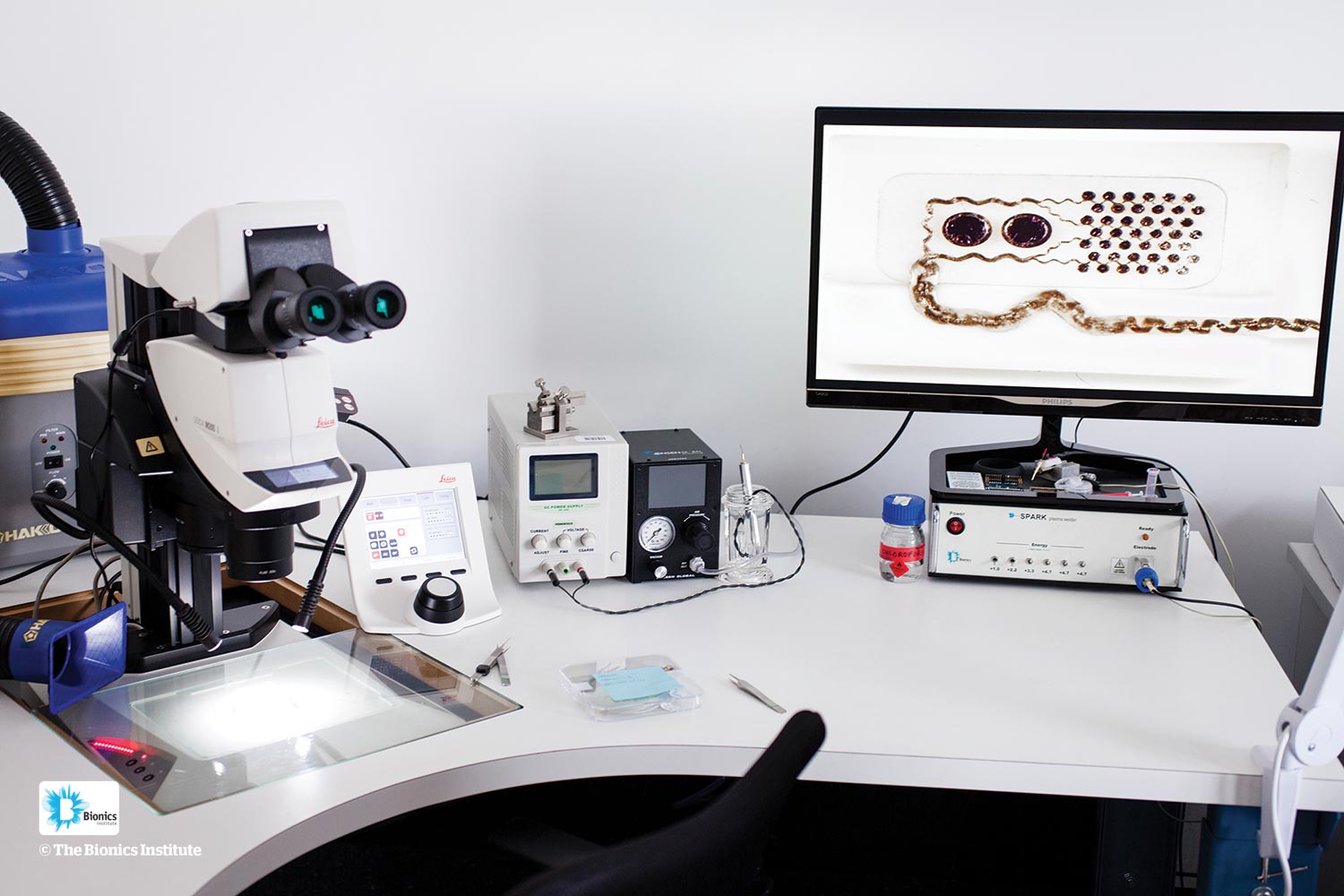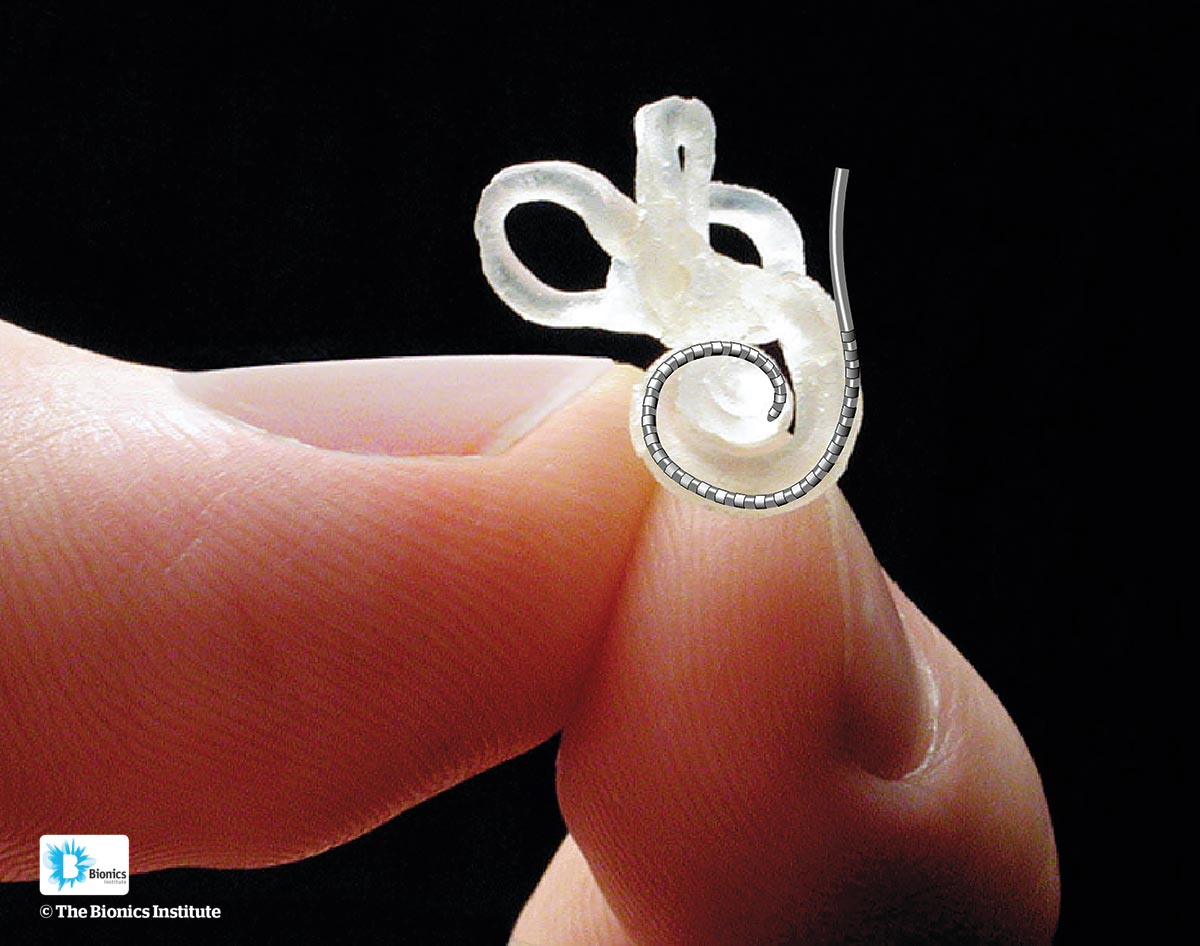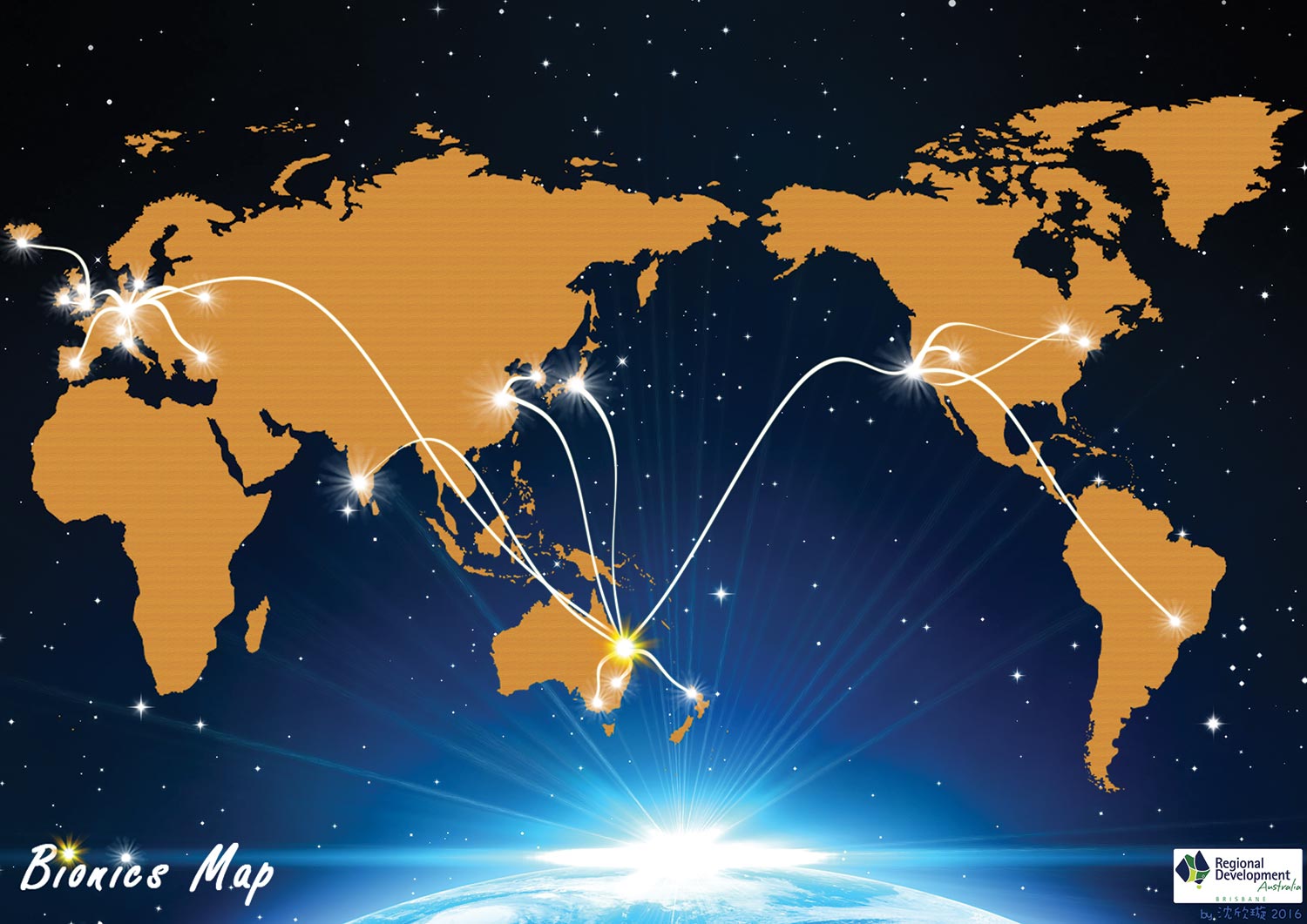G20 Executive Talk Series
September 2016
Human Bionics
Authored by: Dr Robyn Stokes, Australian Business and Marketing Strategist
Human Bionics Interface:
Australia’s G20 Inspired Alliance Accelerating New Global Partnerships
Since the first Innovation 20 was staged in Brisbane, Australia in 2014, unique possibilities have continued to unfold for Australia’s leaders and global collaborators in the field of human bionics.

One of the rapid high growth industries of the 21st century (with a combined global bionics and artificial organs market of USD 38.75 billion projected by 2020), the new science of human bionics emerged with the first successful commercialisation of a neuromodulation device, the Australian-invented multi-channel cochlear implant (bionic ear). This device has transformed the lives of people the world over and other bionic devices are now fast emerging to treat a range of other sensory and previously untreated medical conditions.
During Australia’s G20 year, Brisbane-based healthcare leader, Dr Dimity Dornan, resolved to set up an organisation that would give the human bionics field even greater momentum. Human Bionics Interface (HBI) was born, creating a unique initiative for scientists, investors, researchers and bionics clusters around the world to cross-pollinate ideas, build partnerships and discover new funding sources to rapidly integrate and translate new therapies into practice.
The umbrella goals of the G20 inspired alliance align well with the vision and aspirations of the 11th G20 Summit in China. President Xi Jinping’s focus on an innovative, invigorated, interconnected and inclusive world economy (G20 Official Site) speaks to the need to explore new paths and forge closer international economic ties, giving a high priority to innovations in science and technology. For Australia’s Dr Dornan, a guest speaker at Neuroscience 20 (N20+) in Chongqing, “developing an ecosystem to share activities and build partnerships across borders is the best possible way to create agile human bionics projects and unlock the commercial potential of new devices and technologies”.
“What we will achieve through Human Bionics Interface is an interactive environment or living laboratory”, she said, “one that will help to accelerate bionic breakthroughs to help people a whole lot faster. Treatments for neurological disorders like Parkinson’s disease or epilepsy, the creation of brain-computer interfaces e.g. thought-activated bionic limbs, the bionic eye and bionic replacement organs will start to happen much sooner if we all aim to boost our trans-disciplinary cooperation. The probability of improved outcomes for patients and their families and reduced health budgets in all nations will be much higher”.

As the founder and visionary behind Hear and Say Centres in Australia that use the bionic ear to teach many thousands of children to listen and speak, Dr Dornan said, “Greater linkages between human bionics clusters is especially important to make advances in brain-computer interfaces, neuromodulation devices, bio-fabrication techniques, prosthetics, robotics, organ repair and replacement, neural implants
and much more”.
In sharp contrast to the slow growth economy that G20 leaders have wrestled with at this year’s Summit, the bionics sector is a rising star. As much as 700% growth is projected in some bionics fields in just a few short years. In shaping human bionics solutions for future healthcare, Australia’s Chief Scientist, Dr Alan Finkel says, ‘We have left the era of simple solutions. Products offering transformational benefits will derive from the current convergence of science, technology and the internet’. Yet progress in developing bionic devices in many countries is still quite slow. Innovators and clinicians still have very few avenues to learn from each other, to work together and to attract the necessary funds.
Critical in managing previously untreatable conditions are understandings of the complex interfaces between bionic devices and the brain which is the common denominator.
The brain and its 86 billion neurones and 100 trillion connections is the most complex entity in the universe with a US$2.5 trillion global economic cost of brain disorders, a figure that is only set to escalate in coming decades. In fact it has been said that, “the quest to understand the brain will be the defining feature of the 21st century” (Kunal Ghosh, 2015, World Economic Forum).

Lack of understanding of how the brain functions at every level is still the major obstacle to progress in the bionics arena.
The bionic ear, the bionic eye (now well advanced) and bionic spine (to be trialled in Australia in 2017) plus an array of thought-activated bionic limbs only function well if a set of accompanying conditions are met. Scientists must interface the bionic device with an actual human being, and therefore, appropriate brain training must be provided to the end user. In this regard, professional and family education is not keeping pace. As with cochlear implants, bionic devices do not work if the human brain is not trained to use the technology and here, there is much more to be done.
![]() In sharp contrast to the slow growth economy that G20 leaders have wrestled with at this year’s Summit, the bionics sector is a rising star. As much as 700% growth is projected in some bionics fields in just a few short years.
In sharp contrast to the slow growth economy that G20 leaders have wrestled with at this year’s Summit, the bionics sector is a rising star. As much as 700% growth is projected in some bionics fields in just a few short years.![]()
The bionic spine project, led by Professor Terence O’Brien in Melbourne, Australia (with a team of 39 neurologists and bio-medical engineers from Melbourne University and the Florey Institute of Neuroscience and Mental Health) is a perfect example of the brain-technology interface. The key to the bionic spine is a stent the size of a paper clip that is inserted into the jugular vein and pushed upwards to the motor cortex, the part of the brain that controls movement. The stent is like a recording device that collects the electrical activity from neurons in the patient’s motor cortex before translating the activity into commands. The transmitter then sends the commands wirelessly to an exoskeleton – or to a wheelchair. The vision through this device is to return function and mobility to patients with complete paralysis.

Dr Babak Kateb, global founder and CEO of the Society for Brain Mapping and Therapeutics (SBMT) and its companion foundation, World Brain Mapping (BMF) who is in China for the N20+(Neuroscience 20+) says the “cost of neurological disorder to the global economy is staggering which demands an innovative solution to this challenge”. Dr Kateb who is convening the N20+ with Dr Yao Lu, a professor of Neurology in Chongqing said his motive in starting the N20 was “to engage scientists, engineers, physicians and policy makers in a global consortium that would integrate nanotechnology, devices, imaging and cellular therapy through a range of partnerships”.
Dr Babak is encouraging Human Bionics Interface to collaborate with the N20+ consortium to help shape improved global policies to assist scientists to integrate, translate and more rapidly commercialize advanced bionics devices.
To date, Human Bionics Interfaces has already attracted the attention of bionics clusters and major players in the US, UK, India and China and more are expected to use this new initiative to showcase their clusters and projects and forge new collaborations (between end-users, research institutions, clinicians, industry and government). Figure 1 shows the bi-lateral and multi-lateral links that Human Bionics Interface (HBI) has already established.
The Australian Government and the state of Queensland are passionate about the innovation that biomedical and life science projects brings and are endeavouring to connect research centres and start-up companies with like-minded scientists and investors globally. Queensland as the HQ location of Human Bionics Interface (HBI) is rated fifth in the world for its biotechnology innovation potential and has strengths in genetics/genomic services, bio fabrication, early phase clinical trials and manufacturing of niche pharmaceutical products, medical devices and diagnostics.

Mario Pennisi, the CEO of Life Sciences Queensland who led Australia’s Innovation 20 event in 2014, says there is still a real opportunity to showcase what President Barack Obama referred to as Australia’s great health discoveries in his landmark address during Australia’s G20. This year, the state of Queensland has released its own future-oriented Biomedical and Life Sciences Roadmap and the goal is to build a bigger club of high fliers in med-tech and bionics. The success of Cochlear Limited (with sales of over 400,000 cochlear implants since the company began trading) has shown that Australia’s new world city of Brisbane (the state of Queensland’s capital city) is a viable location for high technology manufacturing. The therapeutic medicines and devices sub-sector already employs more than 6,000 people in Queensland.
Growing city and country intelligence and supporting knowledge industries (via real and virtual clusters) are undoubtedly very high priorities of Australia’s Turnbull government. In the context of the national innovation agenda led by Prime Minister Turnbull, Human Bionics Interface (HBI) has also spearheaded a Bionics Queensland (BioniQ) group. Cluster participants and future bionics projects are anticipated in several growing regions within the state of Queensland e.g. Greater Brisbane, the Gold Coast, Toowoomba and the Darling Downs and Tropical North Queensland.
![]() LAST YEAR, SURGEONS FROM PRINCE CHARLES HOSPITAL IN BRISBANE JOINED COLLEAGUES FROM TEXAS AND MELBOURNE IN SUCCESSFULLY REPLACING A SHEEP’S HEART WITH THE DEVICE AND HUMAN TRIALS ARE SET TO BEGIN IN 2018.
LAST YEAR, SURGEONS FROM PRINCE CHARLES HOSPITAL IN BRISBANE JOINED COLLEAGUES FROM TEXAS AND MELBOURNE IN SUCCESSFULLY REPLACING A SHEEP’S HEART WITH THE DEVICE AND HUMAN TRIALS ARE SET TO BEGIN IN 2018.![]()
The human bionics group in the Greater Brisbane region has already established global linkages. Major contributors to the research and development of new devices and treatments are Professor Mia Woodruff’s biomedical engineering team leading the FutureHear prosthetic ear production project using 3D printing technology), the Queensland Eye Institute’s bionic eye solutions, the Asia Pacific Centre for Neuromodulation, the Queensland Brain Institute’s deep brain stimulation work, the Mater Centre for Neuroscience’s Advanced Epilepsy Unit, Chermside Hospital’s next generation bionic heart and the advanced prosthetics group, Partec. The region has been home to world firsts starting with Cochlear’s bionic ear production and development and more recently the first bionic heart designed by Brisbane engineer Dr Daniel Timms. Last year, surgeons from Prince Charles Hospital in Brisbane joined colleagues from Texas and Melbourne in successfully replacing a sheep’s heart with the device and human trials are set to begin in 2018.
Dr Dornan said, “While we are still building links with emerging and mature bionics clusters in various nations, Human Bionics Interface (HBI) will deliver real benefits to participants. Steve Wozniak, cofounder of Apple Inc. with Steve Jobs said recently that change must happen from the top, and we must learn to speak each other’s technological language. Leaders need to think like venture capitalists, with a portfolio approach to digital innovation initiatives and build the technology starting with the end in mind. We must take a similar approach now in accelerating human bionics solutions”, she said, “and capitalise on the dawn of this bionic age to enable improved global health”. Already on the horizon are low cost solutions for cancer pain, implantable simulators to gather data to assist drug delivery and the prevention of infection with body implants, bionic bladders and bio-degradable arterial stents.

Australia’s Human Bionics Interface (HBI) is expected to gain even greater momentum in November this year when the 4th International Medical Bionics Conference is held in Brisbane, Australia. Hosted by the Bionics Institute (headquartered in Melbourne), the Brisbane conference is set to attract a number of national and international experts. According to Dr Dornan, new ties and project collaborations with med-tech clusters and bionics institutes visiting from Europe e.g. France and Switzerland will be explored during this event. When Germany stages its G20 in 2017, it is likely that Human Bionics Interface (HBI) will further extend these European links and establish new connections with cluster leaders and investors in North America, China and India. In the meantime, HBI invites G20 healthcare leaders, interested clinicians, researchers, device manufacturers and bionics investors to access the website (www.bionicsqueensland.org.au/hbi) and contact Dr Dimity Dornan directly (dimity.dornan@hearandsay.com.au) to discuss how HBI can showcase their cluster, enterprise or project and open the door to new collaborations.
Dr Robyn Stokes is an Australian business strategist and foundation member of Bionics Queensland. Twitter: @brisrobyn

Dr Dimity Dornan Founder of HBI and Hear and Say